ASEAN Prefab Wood Buildings Market Size
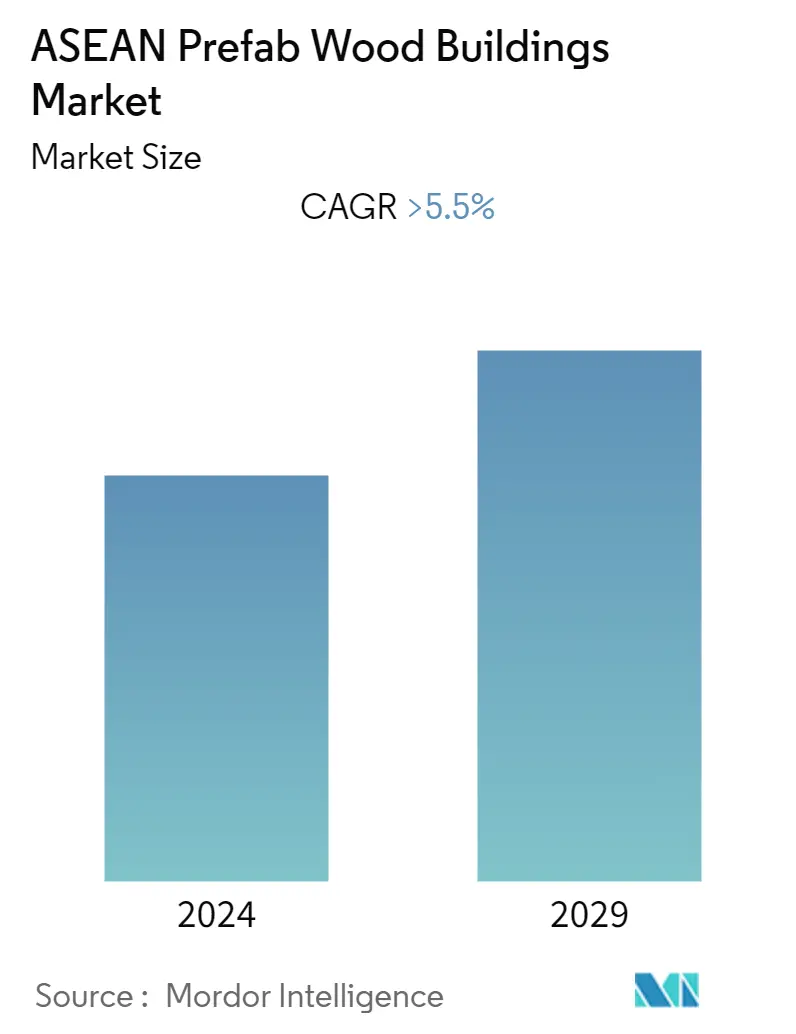
| Study Period | 2020 - 2029 |
| Base Year For Estimation | 2023 |
| Forecast Data Period | 2024 - 2029 |
| Historical Data Period | 2020 - 2022 |
| CAGR | 5.50 % |
Major Players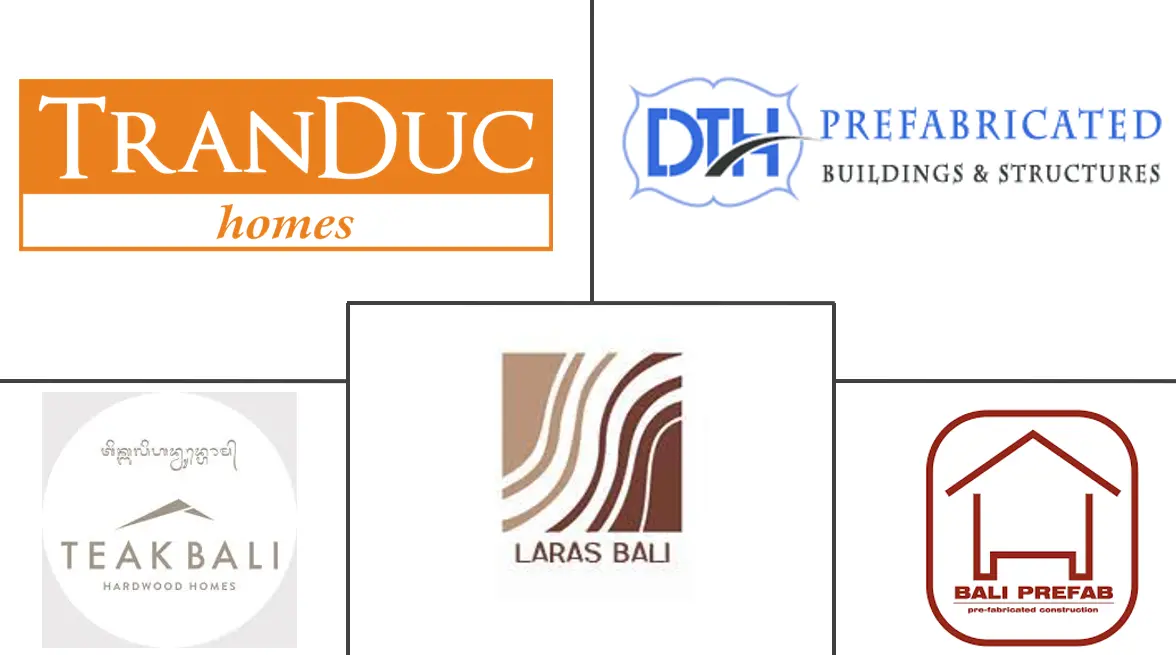
*Disclaimer: Major Players sorted in no particular order |
ASEAN Prefab Wood Buildings Market Analysis
The ASEAN Prefab Wood Buildings Market is expected to grow at a CAGR of more than 5.5% during the forecast period. During the COVID-19 outbreak, the workers fled to their home countries. Due to labor shortage, timely completion of the projects also became a major challenge for developers. Moreover, due to the supply chain disruption, developers faced the problem of obtaining cheap input materials as the production units were closed.
Countries such as Indonesia, Philippines and Thailand are expected to experience significant urbanization growth. Most countries in Southeast Asia are facing growing environmental problems-the natural consequence of economic development. Sustainable construction has been growing in Southeast Asia, including Malaysia. Recently, many new developers and contractors have switched from traditional buildings to prefabricated buildings to adapt to this new trend in the Thai residential market. As sustainable building initiatives continue to be a main discussion topic around the world, green sustainable building standards are progressively becoming the norm, and for here in Vietnam, it is expected that these green buildings to quickly become the most sought-after buildings and spaces in the market to occupiers.
Prefabricated wooden buildings have an opportunity to grow as the cost of traditional construction has increased in the region as a result of a labor shortage and rising fuel and construction material prices. In Thailand housing prices are projected to rise by 5-10% this year 2023 as the standard home construction price index continued an upward trend, with a year-on-year increase of 5.6% in the fourth quarter of 2022 amid a labour shortage. In Malaysia all building materials recorded increases in May 2022 as compared to a year ago. The unit price index of building materials increased between 4.1 per cent to 19.9 per cent. The price index per unit of steel and steel & sections increased by 19.9 per cent and 18.1 per cent respectively in May 2022 as compared to May 2021. In addition, the price index per unit of cement also increased by 12.4 per cent during the period. In March 2022, Vietnam Association of Building Materials stated that due to the sharp increase in input costs, especially petroleum, businesses are forced to increase prices.
ASEAN Prefab Wood Buildings Market Trends
This section covers the major market trends shaping the ASEAN Prefab Wood Buildings Market according to our research experts:
Demand of Prefab Buildings in Indonesia Driving the Market
With the increasing cost of land and contractors in the country, many Indonesians are seeking out more affordable ways to design and build a home to their liking. For some, these considerations lead to prefab houses which are homes made from prefabricated components. The need for housing is anticipated to rise by 72% until 2045 as a result of Indonesia's population expansion. The price of real estate is increasing at the same time, making it harder to find affordable housing. As a result, a housing scarcity in the country's near future is a possibility. Additionally, Indonesia's market is now dominated by concrete building, which contributes 8% of the world's CO2 emissions. This highlights the need for an innovation in this industry that is both economically and environmentally sustainable.
The construction of prefab houses is indeed much faster than the construction of traditional houses. The Indonesian government gives incentives like a 10% reduction in tax payments to real estate developers who can hand over a new house to a customer within 6 months. Since the beginning of 2021, the use of wood has experienced a very high increase. Wood is now a building construction material with the highest utilization growth compared to other materials such as steel and concrete. Automation of prefabrication and processing results in increased productivity and increased competitiveness of wood materials. It is now even possible to use robotic collaboration to carry out the construction of wood products.
The government through the Ministry of Public Works and Public Housing (PUPR) is targeting the construction of 5 million housing units within five years.
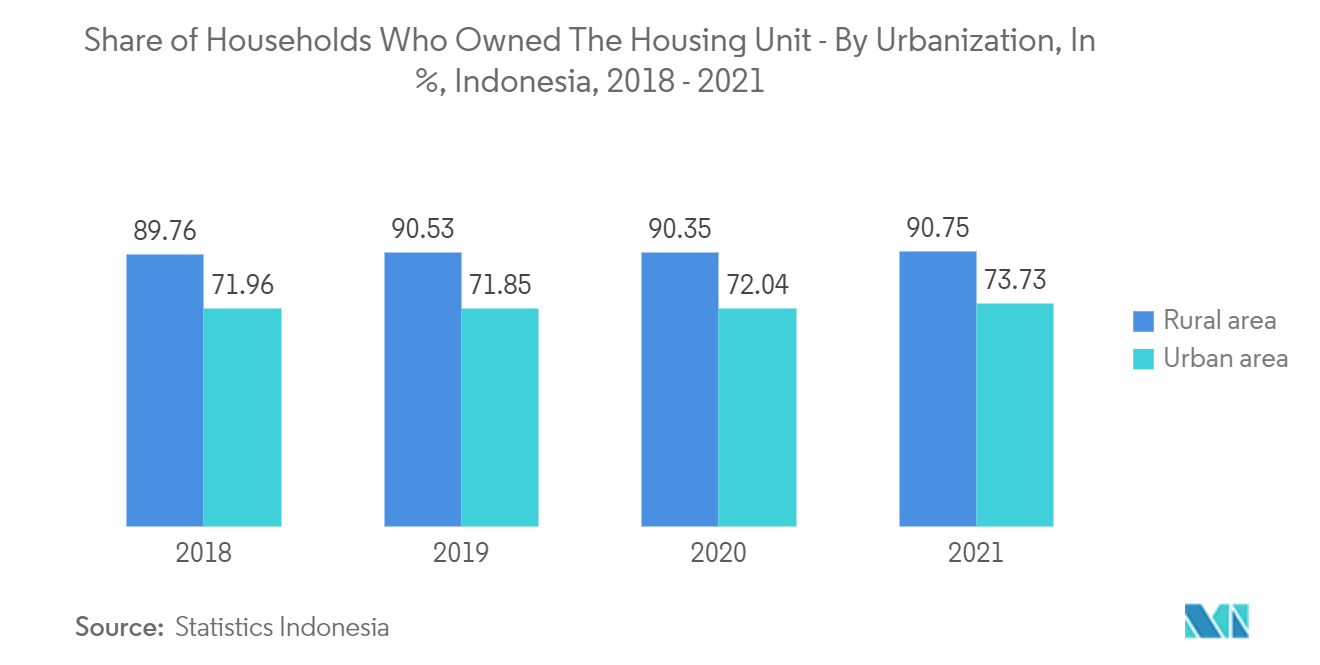
Increasing Adoption of Sustainability In Construction Sector
The carbon reduction in prefabricated buildings has attracted increasing attention due to its importance to low carbon and energy savings in the construction industry. Buildings have a huge potential to reduce energy consumption and greenhouse gas emissions and, in turn, make a real difference in the environment. Southeast Asia's urban population is expected to grow by another 100 million people by 2030, so the region will see greater urbanization and buildings within the next decade.
Vietnam is more exposed to climate risk than nearly any other country in the world. Most recently, in its National Strategy on Climate Change, Vietnam announced a 43.5 percent emissions-reduction target by 2030, sector-specific emissions targets for 2030 and 2050. The Ministry of Construction considers green project development a key measure to achieving the goal of cutting CO2 emissions from building materials production, buildings, and industrial processes by over 74 million tonnes. According to the Ministry of Construction (MoC), Vietnam's housing demand will increase by 70 million square meters each year, equivalent to 17,500 buildings of 30 floors by 2030.
The construction sector has been proven to be one of the contributors to the increase in CO2 and other GHG emissions in Malaysia. Materials such as aluminum, steel, concrete, and bricks are considered to be materials that contribute to high embodied energy. In Singapore, a high-urbanised tropical citystate, buildings are responsible for more than 20 per cent of carbon emissions. Earlier this year, new ambitious sustainability targets were set for the built environment under the Singapore Green Building Masterplan.
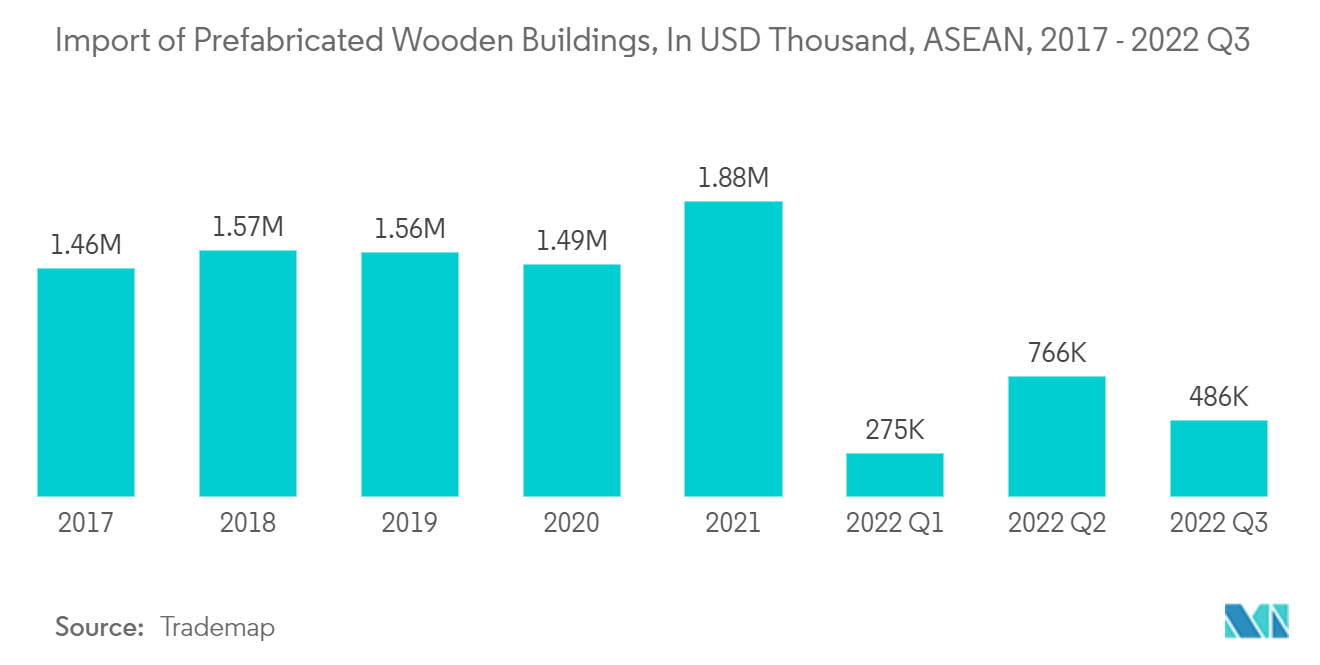
ASEAN Prefab Wood Buildings Industry Overview
The major companies in the ASEAN Prefab Wood Buildings industry are covered in this research. The market is fragmented, but it is likely to grow during the forecast period as prefab construction building investments and upcoming significant projects in various developing and developed countries increase. The major players include Tran Duc Homes, DTH Prefab, PT Teak Bali, Laras Bali Prefab, Bali Prefab House.
ASEAN Prefab Wood Buildings Market Leaders
-
Tran Duc Homes
-
DTH Prefab
-
PT Teak Bali
-
Laras Bali Prefab
-
Bali Prefab House
*Disclaimer: Major Players sorted in no particular order
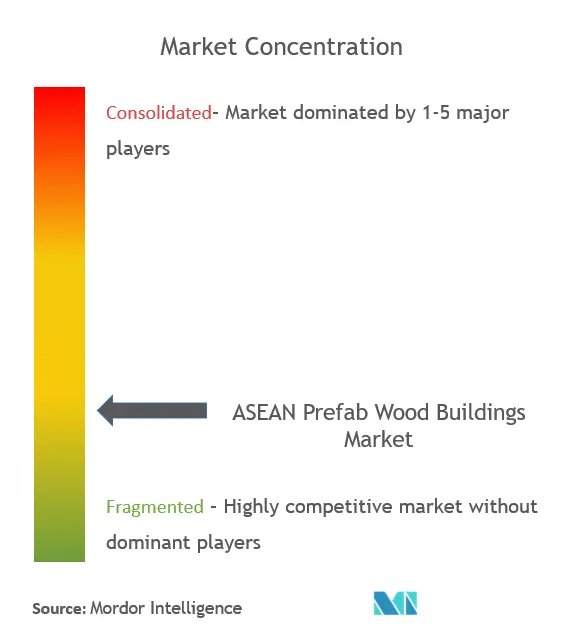
ASEAN Prefab Wood Buildings Market News
October 2022: Stora Enso has launched a wood building kit comprising pre-manufactured, custom-made applications delivered just in time to the building site. The kit aims to enable faster construction, reduced costs, more efficient use of raw materials and fewer emissions than concrete or steel.
October 2022: Construction of the new Nanyang Technological University Academic Building South (NTU ABS) in Singapore is well underway. Upon completion, it will be one of Asia's largest mass-engineered timber (MET) buildings. Aurecon was engaged to deliver civil and structural engineering services. The Aurecon team adopted a modular design approach and prefabricated timber components.
ASEAN Prefab Wood Buildings Market Report - Table of Contents
1. Introduction
- 1.1 Study Assumptions
- 1.2 Scope of the Study
2. Research Methodology
3. Executive Summary
4. Market Insights and Dynamics
- 4.1 Market Overview
-
4.2 Market Dynamics
- 4.2.1 Drivers
- 4.2.2 Restraints
- 4.2.3 Opportunities
-
4.3 Industry Attractiveness Porters Five Forces
- 4.3.1 Threat of New Entrants
- 4.3.2 Bargaining Power of Buyers/Consumers
- 4.3.3 Bargaining Power of Suppliers
- 4.3.4 Threat of Substitute Products
- 4.3.5 Intensity of Competitive Rivalry
- 4.4 Value Chain/Supply Chain Analysis
- 4.5 Technological Advancements
- 4.6 Government Regulations and Initiatives
- 4.7 Brief on Different Structures Used in the Prefabricated Buildings Industry
- 4.8 Cost Structure Analysis of the Prefabricated Buildings Industry
- 4.9 Impact of COVID-19 on the market (Short-term and Long-term Impact on the Market and on the Economy)
5. Market Segmentation
-
5.1 By Panel Systems
- 5.1.1 Cross-laminated timber (CLT) panels
- 5.1.2 Nail-laminated timber (NLT) panels
- 5.1.3 Dowel-laminated timber (DLT) panels
- 5.1.4 Glue-laminated timber (GLT) columns and beams
-
5.2 By Application
- 5.2.1 Single Family Residential
- 5.2.2 Multi-family Residential
- 5.2.3 Office
- 5.2.4 Hospitality
- 5.2.5 Others
-
5.3 By Country
- 5.3.1 Indonesia
- 5.3.2 Thailand
- 5.3.3 Malaysia
- 5.3.4 Singapore
- 5.3.5 Vietnam
- 5.3.6 Philippines
- 5.3.7 Rest of ASEAN
6. Competitive Landscape
- 6.1 Overview (Market Concenttration and Major Players)
-
6.2 Company Profiles
- 6.2.1 Tran Duc Homes
- 6.2.2 DTH Prefab
- 6.2.3 PT Teak Bali
- 6.2.4 Laras Bali Prefab
- 6.2.5 Bali Prefab House
- 6.2.6 Karmod Prefabricated Technologies
- 6.2.7 Thaweephan Wood Products Co. Ltd
- 6.2.8 A.Fold Houses
- 6.2.9 AMD Modular
- 6.2.10 Palmatin*
- *List Not Exhaustive
7. Future Of the Market
8. Appendix
** Subject To AvailablityASEAN Prefab Wood Buildings Industry Segmentation
Prefabricated wood construction kits, similar to life-sized Legos, are constructed out of prefabricated components that are supplied and installed on-site. This is most commonly accomplished by the use of prefabricated panels that may create complete portions of a building, such as roofing components or structure (ceiling, decking, and beams), building structure (wall panels, beams, columns, and shear paneling), and even glazing packages. A complete assessment of the ASEAN Prefab Wood Buildings Market includes an assessment of the economy market overview, market size estimation for key segments, and emerging trends in the market segments in the report. The report sheds a light on the market trends like growth factors, restraints, and opportunities in this sector. The competitive landscape of the ASEAN Prefab Wood Buildings Market is depicted through the profiles of active key players. The report also covers the impact of COVID - 19 on the market and the future projections.
The ASEAN Prefab Wood Buildings Market is segmented By Panel Systems (Cross-laminated timber (CLT) panels, Nail-laminated timber (NLT) panels, Dowel-laminated timber (DLT) panels, Glue-laminated timber (GLT) columns and beams), By Application (Single Family Residential, Multi-family Residential, Office, Hospitality, Others), By Country (Indonesia, Thailand, Malaysia, Singapore, Vietnam, Philippines, Rest of ASEAN). The report offers market size and forecast values (USD billion) for all the above segments.
| By Panel Systems | Cross-laminated timber (CLT) panels |
| Nail-laminated timber (NLT) panels | |
| Dowel-laminated timber (DLT) panels | |
| Glue-laminated timber (GLT) columns and beams | |
| By Application | Single Family Residential |
| Multi-family Residential | |
| Office | |
| Hospitality | |
| Others | |
| By Country | Indonesia |
| Thailand | |
| Malaysia | |
| Singapore | |
| Vietnam | |
| Philippines | |
| Rest of ASEAN |
ASEAN Prefab Wood Buildings Market Research FAQs
What is the current ASEAN Prefab Wood Buildings Market size?
The ASEAN Prefab Wood Buildings Market is projected to register a CAGR of greater than 5.5% during the forecast period (2024-2029)
Who are the key players in ASEAN Prefab Wood Buildings Market?
Tran Duc Homes, DTH Prefab, PT Teak Bali , Laras Bali Prefab and Bali Prefab House are the major companies operating in the ASEAN Prefab Wood Buildings Market.
What years does this ASEAN Prefab Wood Buildings Market cover?
The report covers the ASEAN Prefab Wood Buildings Market historical market size for years: 2020, 2021, 2022 and 2023. The report also forecasts the ASEAN Prefab Wood Buildings Market size for years: 2024, 2025, 2026, 2027, 2028 and 2029.
ASEAN Prefab Wood Buildings Industry Report
Statistics for the 2024 ASEAN Prefab Wood Buildings market share, size and revenue growth rate, created by Mordor Intelligence™ Industry Reports. ASEAN Prefab Wood Buildings analysis includes a market forecast outlook to 2029 and historical overview. Get a sample of this industry analysis as a free report PDF download.



